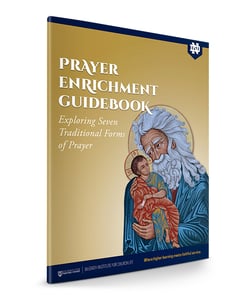
Centering prayer cultivates a disposition of interior silence intended to make room for God. It is a way of disposing ourselves to receive the gift of contemplation, an encounter with God’s presence. As St. John Vianney said of his time in Eucharistic Adoration, “I look at him and he looks at me.” This contemplative gaze or time of being with God is at the heart of centering prayer.
The origins of centering prayer
With roots in the contemplative prayer of the Desert Fathers, centering prayer enacts the Lord’s instruction to “go to your inner room, close the door and pray to your Father in secret” (Matthew 6:6). It emerges from the natural desire to be with God and set our attention on him. Centering prayer as a form of contemplation has grown in popularity in recent decades thanks to the ministry of Fr. Thomas Keating, a member of the Cistercian Order of the Strict Observance.
“Contemplative prayer, in my opinion, is nothing else than a close sharing between friends; it means taking time frequently to be alone with him who we know loves us.” - St. Teresa of Ávila
Why you might pray with centering prayer
All contemplative prayer is a way of being with God more intimately and seeking union with God. Centering prayer in particular is an aid to cultivating the interior disposition requisite for such a relationship. In centering prayer, we make space for God and then invite God into that space. Since interior silence is not a strength of our age, centering prayer will take time and patience to learn. Still, if you desire more opportunities simply to be with God or to focus your attention on God, then centering prayer will likely be worth the effort.
How to practice centering prayer
Pick a time
Set aside at least 20 minutes to practice centering prayer. Later on, you will be able to extend this time, but 20 minutes is enough to begin. Since watching a clock would make centering prayer impossible, look for a timer that can alert you gently when 20 minutes has elapsed. A gentle reminder is best because the end of 20 minutes is a sign to conclude your prayer (not a sign that your prayer has ended), and you don’t want to be startled in this moment.
Select a peaceful space
Look for a space where you can focus on prayer and be undistracted. Environments that we associate with other activities (like our living room or office) can be difficult places to practice centering prayer. Familiar sensory inputs will lead our minds to wander towards the activities we usually associate with those spaces. It is best to find a place where you will be undisturbed. Small interruptions (like traffic outside or the movement of people) tend
to be more distracting for centering prayer than other forms of prayer. With practice, however, you will become more resilient and better able to overcome distraction.
Let go of objectives
The fruits of centering prayer do not come during the prayer itself but in our daily life and relationship with God. Thus, one does not enter centering prayer with an objective in mind like attaining a state of thoughtlessness or achieving some spiritual experience. Nor should one seek to analyze or unpack the thoughts that inevitably arise during centering prayer. Instead, the only goal of centering prayer is to be with God. Like an infant gazing into the eyes of its mother, you have nothing to do during centering prayer except to be present to the Other who is God.
Allow thoughts to pass freely
Thoughts will come and go during centering prayer; this is totally natural. As thoughts arise and fade, do not attempt to “deal” with them in any direct way by fighting them, clinging to them, analyzing them, etc. Instead, gently return to your prayer and continue being present to God.
Know that you might fall asleep
Many people actually fall asleep while practicing centering prayer. This is true of novices and experts alike. If you are going to attempt centering prayer, try to do it at a time of day when you are fully awake and not prone to sleep. If you do happen to fall asleep while praying, just continue praying when you wake up. If you sleep for the whole session, do not count it as a failure! Instead, count it as a gift from God. Thanks to your gentle timer, your accidental nap shouldn’t last longer than 20 minutes anyway.
Steps of centering prayer
Having laid the groundwork above, you are now ready to enter into the steps of centering prayer.
- Choose a sacred word
Choose a word that can draw you into prayer. This word will be like a compass in your hand that helps call you back to interior silence. Because you will return to it often, the shorter and simpler the word, the better. A word like consecration might be meaningful to you, but it might also be more likely to distract you. Consider words like Abba, Jesus or mercy. - Sit comfortably with eyes closed
To get in a posture of prayer, find a comfortable place where you can sit with a straight back and your hands open on your lap. You should be poised to receive but not rigid, relaxed but not slouching. Close your eyes as a sign of letting go of the world around you and making yourself available to God. - Introduce your word
Very gently introduce your word in your mind and let yourself simply be. As thoughts or other distractions arise, call to mind your word (always gently) and let it return you to interior silence. Persist in this state of openness to God until your alarm draws you from prayer. - Withdraw from prayer
When your alarm alerts you, begin to withdraw from prayer. Thank God for the time spent in prayer and let your mind, spirit and body reacclimate to your surroundings. - Trust in God and in your prayer
It’s easy to worry that your centering prayer was a waste of time. Did I do it correctly? Should I have done something else? Why did I get so distracted? These are all temptations. When looking back at your centering prayer, keep two things in mind. First, the fruits of centering prayer rarely come in the moment of prayer itself but instead manifest in other areas of life. Second, a session of centering prayer is time set aside to be with God and make ourselves available to him. A child who climbs into a grandparent’s lap will delight the grandparent whether the child is perfectly still or constantly squirming. We can have similar confidence that our time in centering prayer delights God whether we have been perfectly still or constantly squirming. To believe otherwise is a temptation and not from God.
Download the complete Prayer Enrichment Guidebook
 This article is the third installment of our seven-week Prayer Enrichment Series which comes directly from our free Prayer Enrichment Guidebook.
This article is the third installment of our seven-week Prayer Enrichment Series which comes directly from our free Prayer Enrichment Guidebook.
The Prayer Enrichment Guidebook introduces seven traditional styles of Catholic prayer, including lectio divina, the Examen and centering prayer.
The entry for each prayer practice introduced in this guidebook contains:
- A brief overview of the prayer practice
- Its origins
- Why one might practice it
- How one can practice it
This Prayer Enrichment Guidebook is an aid for all Christians to deepen their relationship with the Lord through new forms of prayer. It is an ideal supplement for Catholic teachers, catechists, ministers and anyone who seeks to encounter God in a new way.



